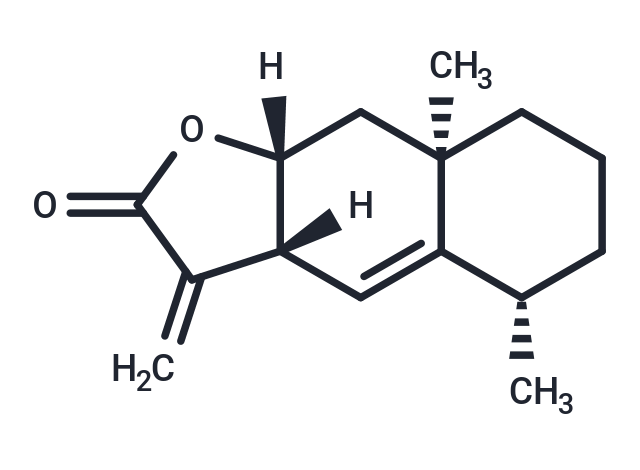Shopping Cart
- Remove All
 Your shopping cart is currently empty
Your shopping cart is currently empty

Alantolactone is a selective inhibitor of STAT3 that induces cancer-associated apoptosis and has antitumor activity.

| Pack Size | Price | Availability | Quantity |
|---|---|---|---|
| 5 mg | $50 | In Stock | |
| 10 mg | $65 | In Stock | |
| 25 mg | $144 | In Stock | |
| 50 mg | $233 | In Stock | |
| 100 mg | $420 | In Stock | |
| 1 mL x 10 mM (in DMSO) | $54 | In Stock |
| Description | Alantolactone is a selective inhibitor of STAT3 that induces cancer-associated apoptosis and has antitumor activity. |
| In vitro | METHODS: The inhibitory effects of Alanolactone (5, 10, 15μM) on the growth of MDA-MB-231, MCF-10A and MCF-7 cells were compared. RESULTS Alanolactone significantly inhibited cell proliferation of MDA-MB-231 cells compared with MCF-10A and MCF-7 cells. [1] METHODS: To investigate the effect of Alantolactone (5, 10, 15 μM) on the expression levels of STAT3-related proteins in MDA-MB-231 cells, Western blot analysis of p-STAT3, STAT3, p-JAK1, JAK1, p-JAK2, JAK2, p-Src, Src, p-ERK, and ERK was performed on MDA-MB-231 cell lysates. RESULTS Alantolactone selectively inhibited STAT3 phosphorylation, thereby suppressing the secondary signaling events of STAT3 inhibition and inhibiting MDA-MB-231 cell proliferation. [1] METHODS: U87, U373, and LN229 glioma cell lines were treated with alantolactone (10-60 μM) for 12 h, and cell viability was measured by MTT assay. RESULTS Alantolactone treatment increased the growth inhibition of U87, U373, and LN229 cells in a dose-dependent manner, with IC50 values of alantolactone for U87, U373, and LN229 cells being 33, 35, and 36 μM, respectively. [2] |
| In vivo | METHODS: To confirm the antitumor effect of Alanolactone in vivo, a xenograft experiment was performed on MDA-MB-231 cells. The cells were injected into athymic nude mice and treated with alanolactone (2.5 mg/kg, intraperitoneal injection, 14 days). RESULTS The average tumor volume of mice treated with alanolactone was approximately 2.17 times lower than that of control mice. Alantolactone administration did not affect the overall body weight and had no obvious toxicity to mice. [1] |
| Cell Research | Cell viability was evaluated using MTT assay. The cells were seeded into 96-well plates and maintained at 37 °C for 24 h. The cells were treated with alantolactone for 24 h. The MTT solution (0.5 mg/mL) was added to each well, and the cells were incubated for another 3 h. The MTT formazan crystals were dissolved in DMSO. The results were obtained by measuring the absorbance at a wavelength of 540 nm using a microplate reader.(Only for Reference) |
| Alias | Inula camphor, Helenine, helenin, Eupatal, Alant camphor, (+)-Alantolactone |
| Molecular Weight | 232.32 |
| Formula | C15H20O2 |
| Cas No. | 546-43-0 |
| Smiles | [H][C@@]12C[C@@]3(C)CCC[C@H](C)C3=C[C@]1([H])C(=C)C(=O)O2 |
| Relative Density. | 1.08g/cm3 |
| Storage | store at low temperature,keep away from direct sunlight | Powder: -20°C for 3 years | In solvent: -80°C for 1 year | Shipping with blue ice. | ||||||||||||||||||||||||||||||||||||||||
| Solubility Information | DMSO: 23.2 mg/mL (99.86 mM), Sonication is recommended. Ethanol: 46 mg/mL (198 mM), Sonication is recommended. | ||||||||||||||||||||||||||||||||||||||||
Solution Preparation Table | |||||||||||||||||||||||||||||||||||||||||
DMSO/Ethanol
Ethanol
| |||||||||||||||||||||||||||||||||||||||||

Copyright © 2015-2025 TargetMol Chemicals Inc. All Rights Reserved.